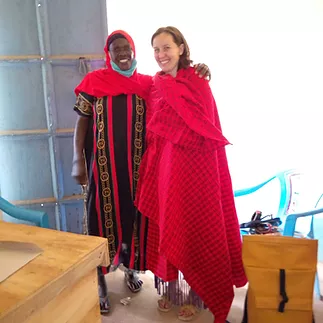A local Kenyan woman and an international volunteer wearing traditional Maasai attire, smiling together inside a People Against Poverty (PaPo) community centre.
Traditional Maasai attire is deeply woven into the cultural identity of the Maasai people, who live across parts of Kenya and northern Tanzania. At the heart of their clothing is the shúkà, a brightly colored cloth, most often red or red with blue or checked patterns, which is wrapped around the body in distinctive ways depending on gender, age, and occasion.
Red holds a special significance: it symbolises strength, courage, and unity.
Women often wear layers of fabric and intricate beadwork that reflect personal and social meaning.
These beads, strung into necklaces, earrings, and bracelets, are not just decorative: they tell stories of age, marital status, and even motherhood. Men, particularly young warriors, might carry spears and style their hair in traditional ways, while women often adorn themselves with wide, flat beaded collars and earrings that stretch the earlobes.
Footwear is usually simple, sandals are sometimes made from recycled materials like old tires. Despite the growing influence of modern clothing in everyday life, traditional Maasai dress remains a proud expression of identity, worn especially during ceremonies, rituals, and important communal gatherings.
It is not just what they wear, it’s who they are.
Photo from this volunteer program👇🏾
Volunteer as a digital competencies trainer in Shianda Mumias,Kakamega county Kenya.








